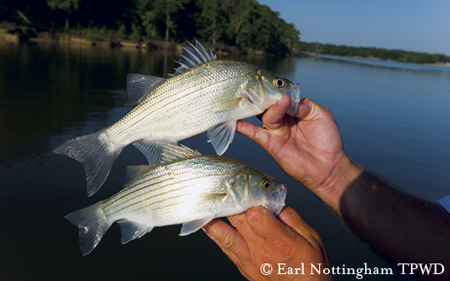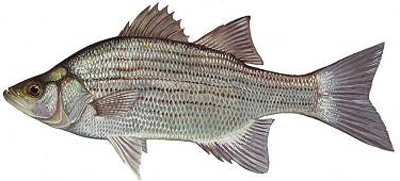White bass (Morone chrysops) are the earliest freshwater spawners
[dropcap]W[/dropcap]hite bass, most of the year, are hunkered down deep in fresh water lakes and not a practical fly angling target – doable, but not highly practiced. Their hot-to-trot spawning window is short-lived and triggered by riverine temperatures that hover around mid 50 degrees Fahrenheit. In southern waters that can occur as early as January. Your target period, no matter the longitude, “can” last for two months. In peak weeks, it can be 50 hook-up days.
Mostly, the action is top-water or near surface – reachable intermediate
Males migrate first – always ahead of their sweethearts by as much as a month. When you see surface chaos – splashing and rolling, the ladies have arrived and that is their spawning profile.
Males, in congregations, are obliged to attend to a single female. The female scatters her “adhesive” 500,000 or so eggs midwater. Quickly, the eggs sink and attach to the bottom – they’re not protected by either parent.
Spawning in a given area usually takes place over a short period, as few as 5- to 6-days to not too much more than a week to 10 days. White bass reaches sexual maturity by age-1 but most by 2-years of age.

White bass in Texas. Image credit as noted
Let’s go fishing. What to expect and how to
The absolute best way to get a favorable tilt is to hire a professional guide. If the water you’re going to fish is not familiar or you’ve not fished it for white bass before. Save time and money, hire a guide.
You don’t need to be a casting wizard to fly fish for white bass. It’s mostly a search effort unless you find them in their spawning incident. Searching – find one and the brothers will be there a month or so before the larger, mating eligible lasses.
Fly Rod
A fly rod over a six weight is overkill unless the riverine or lake hosting white bass share with hybrid bass and striped bass, then a seven should handle all comers. A slow action rod is not the best choice – no matter the fly rod caliber. Think hard, right now hook set with a stiff tip.
This bass species is “super aggressive” and not 2-pound gold fish. They enjoy a good fight. If you’ve never caught one – think angry, head-shaking aerial bonefish.
Reel
Always buy the best reel you can afford. A good reel will easily outlast you and perform as needed without worries of failures. Large arbor always a plus because of “take up” advantage. Avoid Walmart type store purchases, and be careful when buying from big box outdoor stores. Sure-fire is your local fly shop. No, the latter does not mean $$$$.
Fly Lines: Wow, that’s a can of worms
We think OPST’s Commando Lines are the cat’s meow, especially when paired with their Lazar Running Line. Add any “tip” to gain access to the water column the bass are in. Your class tippet (fluoro or mono) can be as short as 5-feet and do the job. This Commando Line and a lightweight switch rod will serve you well from any water vessel (skiff, kayak, canoe), and if shore bound, expand your productivity and up your opportunities, X five compared to your 9-footer with conventional fly lines. Yesterday’s wisdom is intermediate sinking line with the use of tips to reach various water columns. Think 10- to 12-feet.

White Bass courtesy of Texas Parks and Wildlife.
Flies
Anything that looks like a baitfish. This species is a perfect one for a beginner tyer to get rewarded – they’ll hit anything.
About White Bass (Sand Bass, Silver Bass) Morone chrysops:
White bass are widely distributed throughout river systems of the Mississippi and Ohio valleys and the Great Lakes. They are native from the St. Lawrence River in the east, to Lake Winnipeg in the north, and to the Rio Grande in the west. Most abundant in clear lakes and reservoirs, they have been transplanted into the systems of various states including California.
The white bass looks like a shortened version of its larger relative, the striped bass (Morone saxatilis). It has the same silvery white sides and black stripes. It differs most noticeably in being shorter and stockier with a smaller head, and the dorsal fins are set closer together. They can be distinguished from the yellow bass (M. mississippiensis), by its more silvery color and regular, unbroken stripes as well as by its protruding, pugnacious-looking, basslike lower jaw (in the yellow bass the jaws are about equal). It can be distinguished from the white perch (M. americana) by the latter’s lack of prominent stripes on the sides (though stripes may be present in very small juveniles).
White bass are active early spring spawners. Schools of males migrate upstream to spawning areas as much as a month before females. There is no nest preparation. Spawning occurs either near the surface or in midwater. Running water with a gravel or rock substrate is preferred. Females rise to the surface, and several males crowd around as the eggs and sperm are released. Large females sometimes release nearly a million small eggs during the spawning season. After release eggs sink to the bottom and become attached to rocks, hatching in 2-3 days. Fry grow rapidly, feeding on small invertebrates. White bass may grow eight or nine inches during the first year.
Adults are usually found in schools. Feeding occurs near the surface where fish, crustaceans, and emerging insects are found in abundance. Gizzard and threadfin shad are the preferred food items. White bass more than four years of age are rare.
SOURCES About White Bass: Florida Fish and Wildlife Conservation Commission, Texas Parks and Wildlife Department and International Game Fish Association.
International Game Fish Association – All-Tackle world record (tie) 6-pound, 13-ounces – Lake Orange, Virginia and Amitie River, Louisianna.


